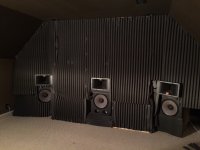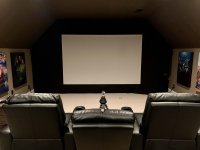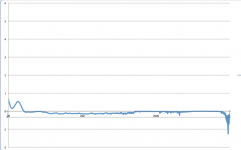Yes, just be sure that you are neither clipping nor down in the dirt when you record. -12dB peaks are a typical spot. You might be able to sneak it up some because you're doing music that has already been leveled and peak controlled. Live music is much less predicable.
Take that file and normalize it to 0dB (or -1dB) in something like audacity or GoldWave.
Yes, this is what I meant by gain matching. Ideally you want as much signal playback (without distorting your system or mic) as possible to maximise the SNR in the recording chain. i.e. turn playback volume up and mic gain down, but without the playback system distorting or overloading the mic and/or preamp stage in the Zoom.
Once done, yes, absolutely you can post process and normalize to 0.5 or -1 dBFS, just like Pano says. Note that any amplification applied also applies to the noise floor of the recording as well.
The DR comparison was simply to catch if anything in the chain is compressing or limiting the signal...
Alright, fellas. I did another round of testing. I think I may have gotten the kinks worked out with your help. Let me know what you think.
This time the testing was done in my home theater. (Just for the record, I'm using a JBL Pro 15" midrange and a 2" compression driver on a huge freaking horn for my left/center/right.)
Dropbox - Test 2.flac - Simplify your life
Thanks again,
Erin
This time the testing was done in my home theater. (Just for the record, I'm using a JBL Pro 15" midrange and a 2" compression driver on a huge freaking horn for my left/center/right.)
Dropbox - Test 2.flac - Simplify your life
Thanks again,
Erin
Last edited:
Here is a quick example of car stereo FM radio I just made using a pair of in ear mics. I also just made those, cost was $7.75 for the pair.
Only editing is to shorten the file, compress the car door peak on the left then normalize to -0.5dB. No EQ.
During the recording I had to turn the input level way down, as these little mic capsules put out a healthy level.
Only editing is to shorten the file, compress the car door peak on the left then normalize to -0.5dB. No EQ.
During the recording I had to turn the input level way down, as these little mic capsules put out a healthy level.
Attachments
I just listened to test2, will go back and listen to the first test.
This one doesn't seem to suffer too much room tone - Mitch, what do you think.
It is surprisingly flat FR up to 10K, tho. Normally music should roll off from Low to High, this does not. What's the system?
This one doesn't seem to suffer too much room tone - Mitch, what do you think.
It is surprisingly flat FR up to 10K, tho. Normally music should roll off from Low to High, this does not. What's the system?
I edited the post above to discuss what I’m using. JBL Pro Cinema 2035’s in 4 cubic foot enclosures mated to 2446j CDs on (forget the waveguide model).
The speakers are about 3 feet from the back wall and a false wall frame (no baffle/actual wall) was put up. Then 2” wedge foam on top of the wall. All covered with black grille cloth and then a 120” acoustically transparent screen.
This is an “in progress” pic. With a final pic and the mic setup as well.


The speakers are about 3 feet from the back wall and a false wall frame (no baffle/actual wall) was put up. Then 2” wedge foam on top of the wall. All covered with black grille cloth and then a 120” acoustically transparent screen.
This is an “in progress” pic. With a final pic and the mic setup as well.


Thanks for the pix! That should sound great. I wonder why it was so bright? Maybe you'll have to record pin noise or sweeps and we can look at them.
Not sure. I haven't measured this system in YEARS. The drivers are ran actively off a Crown xls1502. The crossover point is somewhere in the 600hz area, IIRC. (it's a BIG freaking compression driver and horn) And that horn rolls off above about 8khz, IIRC. So that may very well be why you're seeing the drop off. Too many variables to know for sure without separating them.
The HT setup isn't really what I would call a music listening masterpiece. It gets loud. It is dynamic as all get out. But tonally,... it's ok. My car, however, is a purpose built stereo system. A labor of love. I do all my music listening in there because I spend so much time on it. I don't have a lot of free time at home to listen to music. Many hours of tuning, building, researching, etc spent on my old car so when I got my new one I knew exactly what I wanted to do and did it. And that sucker sounds fantastic. If I say so myself.
So, yea, I am not too terribly concerned with the quality of the system being recorded here. Namely, I'm just trying to make sure that the recordings turn out OK. On my end, they seem to do a good job of replicating what I actually hear in that seat. And the noise level is gone. BUT!!!!!... I also used noise reduction in Audacity. I used a solid 5 seconds of just noise. When A/B'ing between the versions with/without NR, I didn't notice any standouts in or a loss of sound quality between the two. So, I think the combo of NR and normalizing will be what I need for my intended purpose.
Last edited:
Well, the background hiss is pretty unbearable at adequate volume, once I've normalized the track. Here's the same track, without NR.
Dropbox - Test 2 (without NR).flac - Simplify your life
I figure if I always do this, by starting off with about 10 good seconds of silence to use as my noise sample, then it keeps things on an even playing field. The alternative is an unbearable noise floor.
I plotted the specrum of a 40 second clip of music from each track. Didn't see a real difference. So I went a step further and exported the data to a text file then imported both in to excel, took the delta and plotted it. As you can see from the attached delta plot below, there is no appreciable difference until 20khz+. Between 20-20k the largest delta is 0.5dB @ ~35hz. For nearly all of the auditory spectrum the delta is about 0.10dB. Which is an acceptable limit for my purpose. I don't think there's any legitimate argument to be made as to the reduction in sound quality per the reduction in noise. At least based on the data I have on hand.
Dropbox - Test 2 (without NR).flac - Simplify your life
I figure if I always do this, by starting off with about 10 good seconds of silence to use as my noise sample, then it keeps things on an even playing field. The alternative is an unbearable noise floor.
I plotted the specrum of a 40 second clip of music from each track. Didn't see a real difference. So I went a step further and exported the data to a text file then imported both in to excel, took the delta and plotted it. As you can see from the attached delta plot below, there is no appreciable difference until 20khz+. Between 20-20k the largest delta is 0.5dB @ ~35hz. For nearly all of the auditory spectrum the delta is about 0.10dB. Which is an acceptable limit for my purpose. I don't think there's any legitimate argument to be made as to the reduction in sound quality per the reduction in noise. At least based on the data I have on hand.
Attachments
Last edited:
I just listened to test2, will go back and listen to the first test.
This one doesn't seem to suffer too much room tone - Mitch, what do you think.
It is surprisingly flat FR up to 10K, tho. Normally music should roll off from Low to High, this does not. What's the system?
Agreed not much room tone. Recording sounds nice and clear. Did you eq your speakers?
The "Your food is going to get cold" test sounds more natural to me. You did clip the loud parts, but maybe because it's drums it's not bad. Once you turned it down it was good.
Agreed. That's why I asked about the eq. And your kid is so cute in the audio recording
Here is a quick example of car stereo FM radio I just made using a pair of in ear mics. I also just made those, cost was $7.75 for the pair.
Only editing is to shorten the file, compress the car door peak on the left then normalize to -0.5dB. No EQ.
During the recording I had to turn the input level way down, as these little mic capsules put out a healthy level.
Pano, sounds good and realistic!
bikinpunk, can you plug your Sound professional binaural mics into the Zoom you have? Did it come with an aux mic input?
Thanks Mitch. I was kind of surprised how well it did on my voice, considering the mics are in my ears. 
Erin I don't understand why you would be getting too much noise. I have the Zoom H4n, which isn't as quite as the H4nPro, but I'm not have much noise trouble. I don't know why your Zoom would be noisy enough to bother. Strange.
Erin I don't understand why you would be getting too much noise. I have the Zoom H4n, which isn't as quite as the H4nPro, but I'm not have much noise trouble. I don't know why your Zoom would be noisy enough to bother. Strange.
Agreed not much room tone. Recording sounds nice and clear. Did you eq your speakers?
Agreed. That's why I asked about the eq. And your kid is so cute in the audio recording
bikinpunk, can you plug your Sound professional binaural mics into the Zoom you have? Did it come with an aux mic input?
So, the first track I uploaded was taken in my car.
The second was taken in my home theater from the main listening position.
Both systems were EQ'd. The HT recording has less room interaction. The directional horns play a part. And the room is about 17 ft wide x 22 ft deep with 8 or 9 foot ceilings. It is also treated with absorption panels on the sides, a fiberglass filled riser for second row seating which acts as a bass trap, the speakers are about 3 feet off the back wall and the false 'wall' is entirely covered in 2" thick foam wedges. So the room is treated well and the speakers have controlled directivity down to about 500hz with these horns.
No line input on the H3. Just a line out and headphone out.
Erin I don't understand why you would be getting too much noise. I have the Zoom H4n, which isn't as quite as the H4nPro, but I'm not have much noise trouble. I don't know why your Zoom would be noisy enough to bother. Strange.
I wish I knew. But if you go and listen to some of the recordings others provide on the internet of the H3 and the $1k Rode mic, it seems this is par for the course, unfortunately.
Spatial Audio Microphones Self-Noise Comparison (4 Mics) - Atmosphaeres Blog
I'm pretty dang happy with how this last test turned out. And, unfortunately, tracking down and trying other methods is extremely costly. I think I may stop here with the H3. I would like to try this out from binauralenthusiast but 1) I don't know that it would be impervious to noise and 2) even if it were awesome, that's a LOT of money.
B1-E Dummy Head with BE-P1 Binaural Microphones + XLR Adapter – Binaural Enthusiast
I have to reel this back in and remember my goal: to provide a sense of what a speaker is capable of. It will never replace someone listening to the speakers in their own home. It's only meant to give an idea of how the speakers interact with the room. Notably in cases where directivity is high or there's a polar pattern issue. And this will all be in my own room which, again, is not the same listening space others use. If anything this is just a "for fun". And I can't justify $650 "for fun". If I were more concerned with just getting the speaker itself then I would probably do testing in mono, per Toole's writings.
B1-E Dummy Head with BE-P1 Binaural Microphones + XLR Adapter – Binaural Enthusiast
I have to reel this back in and remember my goal: to provide a sense of what a speaker is capable of. It will never replace someone listening to the speakers in their own home. It's only meant to give an idea of how the speakers interact with the room. Notably in cases where directivity is high or there's a polar pattern issue. And this will all be in my own room which, again, is not the same listening space others use. If anything this is just a "for fun". And I can't justify $650 "for fun". If I were more concerned with just getting the speaker itself then I would probably do testing in mono, per Toole's writings.
Last edited:
I think you are in a good place too. I have similar large JBL's as well (4722 Cinema speakers) so familiar with yours. You may want to look into the research that Toole and Olive worked on as far as what in-room response sounds natural to our ears. A summary here.
I have used these before: 3Dio: Professional Binaural Microphones the cheaper version and the Neumann head (really expensive!) when I was recording professionally. But I found the Soundprofessionals mics to record the most realistic binaural audio I have heard.
As a side note, you may be interested in this: GitHub - jaakkopasanen/Impulcifer: Measurement and processing of binaural impulse responses for personalized surround virtualization on headphones. and the bits and pieces around eq'ing the mics for flat response...
I have used these before: 3Dio: Professional Binaural Microphones the cheaper version and the Neumann head (really expensive!) when I was recording professionally. But I found the Soundprofessionals mics to record the most realistic binaural audio I have heard.
As a side note, you may be interested in this: GitHub - jaakkopasanen/Impulcifer: Measurement and processing of binaural impulse responses for personalized surround virtualization on headphones. and the bits and pieces around eq'ing the mics for flat response...
I am looking for a logical, cost-efficient and “ok, that’s fair” method.
...
I’d prefer something that’s efficient and can be replicated easily but also no more than maybe $250-300 if at all possible.
I would definitely look into the DIY route, in this case.
You seem to be familiar with DSP so equalizing the microphone shouldn't be a problem for you.
High SPL capsules are needed, as you discovered yourself already.
- Status
- This old topic is closed. If you want to reopen this topic, contact a moderator using the "Report Post" button.
- Home
- General Interest
- Everything Else
- Suggestions for a stereo system recording method (binaural, etc)?
